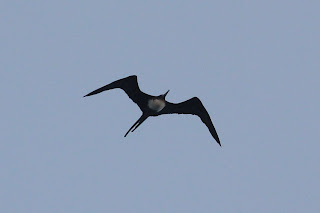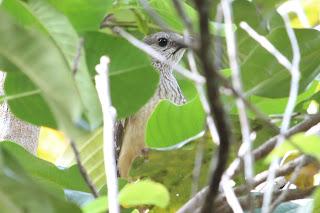We headed on and arrived at Portland Roads. If the morning birding had been a tad disappointing, the Portland Roads Guest House was not! A stunning place overlooking a beautiful tropical bay, complete with fishing boats, palm trees and mangroves. Gorgeous. Just as good, was the cafe next door which provided brilliant meals (calamari, prawns, fish and chips) for very reasonable prices set in a lovely garden full of Olive-backed Sunbirds, and Yellow-spotted and Brown Honeyeaters. Our humour was restored and we set out again to "work" the forest for new species.
This proved to be by far the least productive birding session we had done. We did pick up Tropical Scrub-wren (Number 18) soon after starting, but got nothing new until we snaffled a White-faced Robin (Number 19) just before dusk. We heard lots of other calls, and saw a couple of Eclectus Parrots fly overhead, but that was it. As we headed back, we stopped at the local rubbish tip, supposedly a good spot for Palm Cockatoo. We didn't see them, but we did pick up both Large-tailed Nightjar and White-throated Nightjar (Number 20). OK, three lifers was actually rather good, but I think we were expecting all sorts of stunning beauties literally parading themselves before us. Back home for more delightful seafood and then we settled in for the night after making a cunning plan for the next day and having a close encounter with a Papuan Frogmouth that had clearly made the trees around the guest-house its home. Steve and I shared a room again - enough said.
Photo courtesy of Steve Potter
Photo courtesy of Steve Potter
Black-headed Python
Photo courtesy of Steve Potter
Our third day had us back on Portland Roads. We stopped at the top of a ridge to see if we could find White-streaked Honeyeaters. David locked on to one, but by the time Steve and I arrived, it had gone. And that was the only sighting of this bird the entire trip. It became a sore point. I then walked into a Paper-Nest Wasp nest, and they hammered me in the small gaps between the mozzie and sand-fly bites. Steve got stung too (on the lip, which reminded me of a Vegietales song about lips), while David fled at a ridiculously quick pace to the safety of the road. This also became a sore point - the stings, not David's flight. However, we then worked the main road again and came across Yellow-legged Flycatcher (a pretty little thing - Number 30) and Frilled Monarch (Number 31). Then after following a cuckoo-like call through the undergrowth for some time, we were thrilled to finally track down a Yellow-billed Kingfisher (Number 32 and a new favourite bird)! There was great rejoicing in the forest!
The afternoon consisted of some initial birding around the guest-house, where we picked up Lovely Fairy-wren, and then another attempt at the WS Honeyeater. No sign, but the Red-cheeked Parrots did another fly-over and we were all able to get enough of a view to confirm these elusive little birds (Number 33). We also came across an Eclectus Parrot nest in a very tall tree and got some cracking views of the female in the hole and the male hovering around nearby, having an animated conversation with some Sulphur-crested Cockatoos. We stopped in at Chilli Beach again, and this time scoped some Black-naped Terns (Number 34) roosting on a nearby rocky outcrop. Home to a lovely seafood dinner, and bed. I was tired - fell to sleep almost immediately despite the racket going on around me.
Day four shall forever be remembered as "The Day We Saw Nothing". Despite our best attempts, the Trumpet Manucode, Northern Scrub-Robin and the White-streaked Honeyeaters and Chestnut-breasted Cuckoos (the only targets left on our list!) remained elusive. However, I snaffled eighteen of the twenty-two targets, so I really can't complain. Just means I am going to have to go back there one day to get the other four (plus the Pitta!!). After another yummy seafood dinner, we hit the sack in time for an early start the next day.
Day five consisted of a visit by a Green Tree Frog, a quick check of the Cook's Hut camp-site - nothing, a photo session at the Iron Range sign, and then a long drive back to Julatten and Kingfisher's Park. Getting eighteen lifers in four days anywhere is outstanding, especially ones that are limited to such a small part of Australia, so while the birding was "hard work" at times - Iron Range more than delivered and I am extremely grateful that I had the chance to visit this pearl of a place. I will be back!
Dave Kowalick and Steve Potter













No comments:
Post a Comment